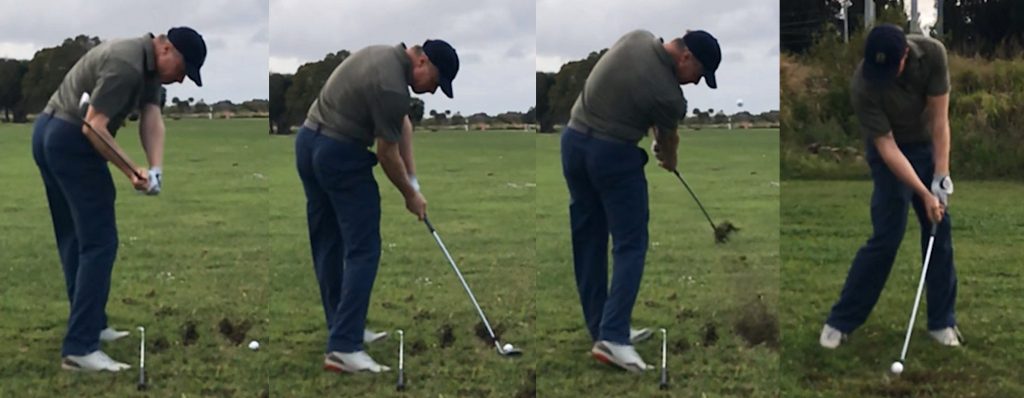 December 30, 2019- by Steven E. Greer
December 30, 2019- by Steven E. Greer
I have made a lot of progress with my swing this year, but something was still off. I was hitting a large percentage of my shots thin or fat. I was flipping the hands, or releasing them early. Nothing I tried could fix it.
Perhaps the most obvious distinction on slow-motion video between a good golfer and a bad golfer is this flipping problem. Some of the best players have been flippers and had wild errant shots as a result. Only a few elite professionals can get the proper delayed release of the shaft and hands after impact. How do they do it?
I was on a mission to understand this phenomenon. It was far more challenging than I expected. What I learned was counterintuitive and surprising.
My first observation was that my own swing was arcing out too far behind the ball. I traced my sternum and it was about six-inches too far behind the ball at impact.
I then started to analyze the angle, from the front view, of my sternum, or shirt buttons. I was at least 30-degrees tilted too far to my right side compared to good players.
So, I had my goal: to fix that spine tilt. But how? I have found no good YouTube or any other advice on this matter.
In desperation, I got the idea to try to emulate the extreme swing of Jim Furyk. I knew that his torso was facing the target at impact more than almost any other player. So, I reasoned that, if I could do that, it might teach me the feel for fixing the spine tilt.
I realized that Furyk does two things in his early downswing that are unique. He gets a huge turn of his right hip joint. His sacrum and guteal muscles are facing away from the target. Then, to prevent coming over the top with his arms, he flexes, or pulls backward, his right upper arm.
I developed what I jokingly call the Arm-to-Ars drill. I get the hyper rotation of the pelvis while flexing the upper arm. The hands come into contact with the hip.
I then realized that the swing has to be completed from there. The sternum has to arc downward and to the player’s left. For a flipper, this is a scary and strange move. It feels like you are throwing your body to the ground.
After all of that, these are my big lessons or insights from the last week:
A) You actually do not try to correct flipping by working with the hands. The hands are the most obvious symptom of flipping, but they are just a symptom and not a cause. Once the shoulders finish turning, then the hands are released. The real cause of the flipping problem is the fact that the shoulders are turning too soon in the swing.
B) In order to correct the shoulders being out of sync with the hips (also referred to as “fast hips”, which are really better viewed as delayed shoulders), you have to manipulate the spine. It is counterintuitive, but you fix the angle of the upper spine by working with the tailbone (i.e. sacrum and pelvis). That is what the Jim Furyk moves taught me.
C) Once you get the spine maintaining a proper center of gravity throughout impact and beyond, you will feel that the right hip joint turns much more before the arms release. That is because the shoulders are now in synchrony with the hips. The swing is then completed by the right shoulder turning down towards the ground. It feels dramatic, as if the upper body is lunging to the ground.
In summary, “flipping” is a common problem caused by the shoulders turning too soon before impact, which is caused by the hips not fully turning into impact. The flipping of the hands is just a symptom.
One corrects flipping not by holding onto the hands but rather by fixing the tilted spine and premature shoulder turning. All of this is facilitated with lose flexed knees as opposed to rigid straight legs. Learn to flex the legs in the downswing (different body shapes require more or less of this Tiger dipping).
